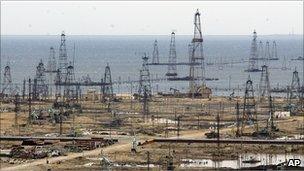Wikileaks: site list reveals US sensitivities
- Published

The oil pipeline which crosses the Caucasus, from Azerbaijan to Turkey, is on the US list
Of all the leaks to have emerged from this set of releases from Wikileaks, this global list of infrastructure sites which the US considers critical for its national security interest must surely count as one of the most sensitive. In its preamble, the cable from the US State Department in 2009 specifically notes it was compiled to try to protect US interests from terrorists.
In their own defence, those working with Wikileaks have pointed out that they deliberately removed details of names and locations from the secret list.
But that has not impressed those who deal with national security issues.
In London the British government condemned the leak unreservedly. The British national security adviser, Sir Peter Ricketts, has asked all government departments to review their computer security.
And Sir Paul Lever, former chair of the Joint Intelligence Committee, called the leak grossly irresponsible.
Global supply chain
But now the information is out in the public domain, it is worth considering in general terms what it tells us about what is nowadays seen as sensitive: what sort of facilities are included and - just as interesting - which ones are omitted.
First off, one must note that this is not a list of military facilities. You will not, for instance, find any mention of Diego Garcia, the US military base built on land leased from the UK in the middle of the Indian Ocean which has proved so critical for the recent conflict in Afghanistan.
Instead it is a list of key facilities which, if attacked, could disrupt the global supply chain and global communications, as well as goods and services critical to the wellbeing of the US and its economy.
What hits you first and foremost is how important on this list is the unseen network of cables that lie on the ocean bed, linking up the American continent across the Pacific Ocean to New Zealand, Australia, China and other US allies in Asia.
Similarly, on Europe's coastline it is the cables that reach from the United Kingdom and Ireland northwards and stretch across the US and Canada that apparently give the US government cause to worry.
And these are not the only maritime considerations. We may operate in a new world of virtual communications, but (along with space communications no doubt) what is carried by or under water is still, it seems, essential.
High on the list of concerns are major port hubs - in China, Japan and South Korea, or critical sea lanes, like the Straits of Hormuz in the Gulf that carries so much of the world's oil and gas supplies, and the Straits of Malacca between Singapore, Malaysia and Indonesia.
The Panama Canal is mentioned. But if warmer temperatures open up the north-west and north-east passages in the Arctic, one has to wonder - for how much longer?
Pharmaceutical emphasis
Intriguingly, the Bosphorus Straits, once surely a Cold War strategic point of interest - the only exit point into the wider Mediterranean for the Soviet Black Sea Fleet - is no longer considered a priority.
Instead in Turkey and the Caucasus, it is the Baku-Tibilisi-Ceyhan pipeline that merits a mention: just one of many strategic pipelines criss-crossing Eurasia that are listed - the only reason several post-Soviet republics like Georgia, Azerbaijan and Belarus are included.
Also striking, but perhaps not surprising, is the predominance of mines that produce rare or much-needed metals which are considered worthy of protection, especially in South Africa and Australia.
But perhaps most surprising of all is the long list of pharmaceutical facilities in Europe that are apparently of vital importance nowadays.
Who would have guessed that it is Tamiflu and typhoid vaccines in Switzerland, anti-snake bite venom in Italy, foot and mouth vaccines in the UK and numerous drugs-making sites in Germany that make Europe worthy of so much attention from those who worry about US national security?
The fear of global pandemics or even biological warfare is a subject of considerable discussion, one presumes.
And the omissions? Perhaps the most significant is the lack of any attention to civil nuclear power plants outside of the United States. Fears about nuclear non-proliferation from rogue states continue to plague diplomats and defence strategists, of course.
But if the inference from this list is correct, it seems that when it comes to civil nuclear power, we have moved into an age of asymmetrical threats, fluid and often unpredictable.
Other potential soft targets have moved centre stage, and perhaps the days have gone when security planners believe a terrorist attack on a civil nuclear plant to wage nuclear war or cause nuclear panic is either particularly likely or necessarily globally devastating.